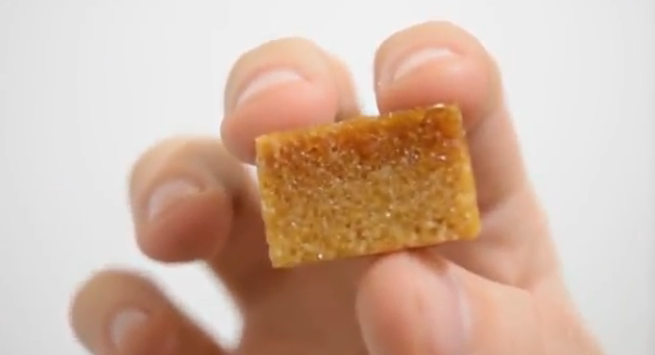When I first saw the following video which is in Spanish
当我第一次看到下面西班牙语版本的视频
I wanted to share it with my friends. Even those who don't speak Spanish.
我想和我的朋友们分享。即使是不会说西班牙语的人。
So, in collaboration with Arcadi Garcia, who made the original,
所以,和制作原版的阿尔卡迪·加西亚合作,
here is Gastrofisica in English.
这里我用英语来讲述美食物理学。
Sugar or, at least, refined sugar is a white, odorless, fine-grained material,
糖-或者至少精制糖是白色、无味、细粒的材料,
which means that, in some ways, it behaves like a liquid.
这意味着,在某些方面,具有液体的特征。
Caramel, on the other hand, is … Uhhh … No. How does THIS turn into THIS?
另一方面,焦糖是……呃……呃……呃……这些细粒的白糖怎么会变成焦糖?
Well, it can't be that complicated, right?
嗯,不会那么复杂的,对吧?
You heat up the sugar, the sugar melts,
你加热糖,糖熔化,
and then begins the process of caramelization,
然后开始焦糖化的过程,
which is a hot, sweet, sticky mess of crazy chemical shenanigans we're not going to get into;
这个是我们无法理解的疯狂化学反应恶作剧,热量,甜味和粘性在这一过程中相互作用。
first because we'd have to get into too much chemistry, and second because you know WHAT?
首先因为我们要了解这其中发生了太多的化学反应,其次因为你知道什么?
This whole caramel thing isn't as simple as it looks.
焦糖形成的全过程并不像看起来那么简单。
First, we've got the chemical process of caramelization, which isn't very well understood.
首先,我们已经了解到了焦糖化的化学过程,这并不是很好理解。
We know that it's complex, that it creates hundreds of different compounds
我们知道这个过程很复杂,在这个过程中,产生了数百种不同的化合物,
and that it involves LOADS of chemical reactions that, as I said, we're not going to get into,
涉及到了大量的化学反应,正如我所说,我们理解不了的,
and anyway we don't understand it anywhere near 100%.
总而言之,我们都不能百分之百了解关于这个过程的每个细节。
And don't get me started on melting sugar!
我不会现在就把糖熔化!
Because I mean, in the first place, what temperature does sugar even melt at?
因为我的意思是,首先,糖在什么温度下会熔化?
Different studies people have done on this don't agree.
人们对此所做的不同研究并不一致。
Some say this temperature. Some say that temperature.
有人说是这个温度。也有人说是那个温度。
In the end, it all seems to hang on whether to reach this or that temperature
最后,这一切似乎都取决于你加热糖的速度是快还是慢,
you heat up the sugar fast or slow.
是达到这个温度还是那个温度。
Except the whole delightful concept of "melting point" is precisely that,
除了关于这一令人愉快的“熔点”的全部概念,确切地说,
at the same pressure and so on,
相同的压力等等,
the temperature at which something melts will always be the same,
任何东西熔化的温度都是一样的,
no matter how you got there!
不管你用什么方式去达到这个目的!
The point of temperature is to give us an idea
温度的意义是让我们知道

of how much kinetic energy the molecules of a given substance have; how fast they move.
给定物质的分子有多少动能,它们运动的速度有多快。
In order to melt, the molecules in a solid need, at the very least,
为了达到熔化的效果,固体中的分子至少需要
a certain amount of energy to break free from their neighbors,
一定量的能量来从它们的相邻分子中释放出来,
and that energy depends on the substance they belong to.
而这种能量取决于它们所属的物质。
Like, at atmospheric pressure, water always melts at 0ºC,
就像,在大气压的作用下,冰总是在零摄氏度熔化,
gallium at about 30ºC which is why it melts in your hand,
镓总是在30摄氏度左右熔化,这就是为什么它会在你的手中熔化,
iron melts at around 1500ºC and sugar, apparently, whenever the heck it feels like it.
铁在1500摄氏度左右熔化,而糖,显然,无论什么时候都感觉在熔化。
But if sugar - or, in other words, sucrose melts, like, whenever it gets around to melting,
但如果糖,或者,换句话说,蔗糖熔化,就像,每当它开始熔化时,
that's because it doesn't actually melt: before getting to that point,
那是因为它实际上并没有熔化:在达到可以熔化的条件之前,
it breaks into its components: glucose and fructose.
它会分解成葡萄糖和果糖这两种成分。
Glucose and fructose, which are more stable, DO have real, proper melting points,
葡萄糖和果糖更稳定,它们有确切的、适当的熔点,
and DO melt the way we think of when we think of things melting,
当我们想到一些具备熔化条件的东西时,它们就会像我们想象的那种方式熔化。
and they're what you see when sugar "melts"
当糖“熔化”时,你就会看到糖的状态
(you can't … you can't see me, but I'm making some crazy air quotes over here).
(你不能……你看不到我,但是我在这里做了一些疯狂的手势引号)。
Most recipes for making caramel talk about heating your oven up to 160ºC-180ºC [320°F - 355°F].
大多数制作焦糖的食谱都说要把烤箱加热到160到180摄氏度(相当于320到355华氏度)
And if you want to make it in a pot or whatever (like we're doing in this video),
如果你想在锅里或者其他什么容器里制作焦糖的话(就像我们在视频里做的那样),
you can get things up to more or less that same temperature.
你可以把温度提高到差不多同样的温度。
But to simply break sucrose into glucose and fructose, we don't need that much heat!
但是,简单地把蔗糖分解成葡萄糖和果糖,这个过程不需要消耗那么多的热量!
That is, if we control our excitement and instead keep the temperature around 150ºC [300°F]
也就是说,如果我们控制我们的兴奋,而是将温度保持在150摄氏度(相当于300华氏度)左右
but for a longer time, we can make caramel without having to melt anything:
但保持的时间更长,我们可以不需要熔化任何东西制作焦糖:
it just goes directly from solid to solid!
它只是直接从一种固体形态到另一种固体形态!
To give this a shot, we tried to dry-caramelize some sugar cubes.
为了给这个说法做个尝试,我们试图将一些方糖烤干焦糖化。
With the oven set to 150ºC[300°F], after 3 and a half hours, these beauties are coming out!
烤箱设定在150摄氏度(相当于300华氏度),3个半小时后,这些精致的焦糖成品就新鲜出炉了!
I mean, how sweet are these? Perfectly caramelized sugar cubes without melting a single thing!
我是说,这些焦糖有多甜?完全焦糖化的方糖,不需要熔化任何东西!
They're sugar cubes, except, you know, caramel sugar cubes.
它们是方糖,除了焦糖方糖。
They taste like caramel, they smell like caramel, they are caramel. In the form of a sugar cube.
尝起来像焦糖,闻起来也像焦糖,它们是方糖形状的焦糖。
And yup, we were able to do all of this just because we tried to understand the physics of caramel.
是的,我们做的这一切仅仅是因为我们试图理解焦糖的物理特性。
Delicious, delicious, physics.
有趣的美食物理学。











